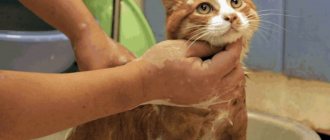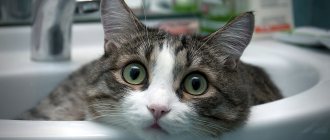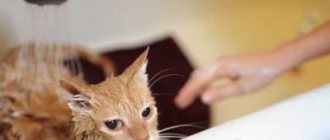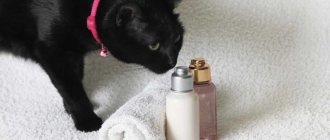How often can you wash your cat?
Cats do not need to be washed daily or weekly; bathing once every 2 months is considered normal.
Watching the cat, it is easy to notice that in her free time from playing and feeding, she likes to “preen” - licking her fur, paws and tail. The animal keeps its fur clean on its own, so it does not need regular bathing. Moreover, too frequent washing can harm the cat, as the pet's subcutaneous glands produce a protective lubricant. The substance is distributed throughout the coat, makes the hair silky, and also serves as a barrier against bacteria. Interesting fact: cats and cats groom themselves differently. Cats spend more time licking their fur and do it more thoroughly than males.
It is important to distinguish between thoroughly washing the cat with shampoo and wiping individual areas of the coat as it gets dirty. If the cat got dirty in the toilet or came home from the street, wipe off the dirt with a soft cloth previously moistened in warm water. This will not harm the pet.
You need to teach a kitten to wash from the age of 4-5 months, so that bathing becomes a habitual ritual, and, as an adult, he would not experience fear of water. In any case, you will have to wash your domestic cat throughout its life, because its fur gets dirty and matted, and you really want the “fur coat” to always be luxurious and well-groomed!
The importance of compliance with these standards
One of the main reasons why cats refuse to bathe is an anxious situation. Everything scares animals:
- noise;
- lack of support;
- moisture;
- getting drops on the head, eyes, ears;
- unfamiliar sensations.
Often, a kitten jumps out of a basin or bathtub in fright because it is very cold or hot. Because of the first unsuccessful bathing experience, it is often impossible to persuade the animal to repeat water procedures.
Possible consequences of non-compliance with temperature conditions
The danger of hypothermia is that it increases the risk of developing colds. Against this background, hypothermia often occurs. Most often, owners of small kittens face this problem.
An animal at an early age is not able to regulate its own body temperature, quickly freezes, and because of this, the functioning of the digestive system is disrupted. Accordingly, the body does not absorb nutrients. The pet cannot keep warm.
The risk of death in such a situation is high .
You need to seek help from a veterinary clinic. The skin of pets is very sensitive, so there is a high probability of getting a burn. The owner thinks the water is warm, but for the animal it turns out to be hot. Overheating develops and burns appear.
Another problem that arises when these standards are not followed is dry skin. Such changes are observed when bathing in cold or hot liquid, or when washing the cat frequently.
When should you bathe a cat?
It is necessary to bathe a cat only if there are good reasons for doing so. Indications for washing your pet:
- More than 2-3 months have passed since the last bath, and the cat’s fur has become dull, darkened, and matted;
- the cat is very dirty, for example, rolled in the mud or covered in paint;
- If parasites are found in the fur, you need to immediately bathe the cat and then treat the “fur coat” with an antiparasitic agent. You should especially carefully examine cats that are often outdoors and can “catch” ticks and fleas;
- washing may be recommended by a veterinarian if a cat develops allergies, lichen, dermatitis and other skin-related diseases;
- if you find a kitten on the street and decide to take it into the house, then you cannot do without water procedures;
- In preparation for the exhibition, you will have to wash the cat with a special shampoo and give your pet a “styling.”
Contraindications to bath procedures
But bathing procedures are not always beneficial for kittens. They have their contraindications:
- Age. You should not bathe a kitten until it is three months old. During infancy, the sebum glands actively develop. Bathing can cause a malfunction of the epidermis, and the kitten will be deprived of the amount of skin lubricant it needs. This is where skin problems begin: all kinds of dermatitis and other troubles. But this does not apply to kittens that were brought from the street.
- Graft. Even a person after vaccination is not recommended to wet the injection site. For kittens, the situation is more serious. The thing is that wet fur does not retain heat, and the cat begins to feel very cold. The kitten may even catch a cold. And vaccination and disease are incompatible things.
- Disease. Here the decision is made by the veterinarian. But if there is no strict need to bathe your pet at this very moment, then it is better not to do this.
I know that bathing kittens under three months is not recommended, but I had to do this several times with a month-old baby. My cat had a particularly restless specimen in her litter. They lived in the yard; the area to be surveyed was huge. But he was drawn exclusively to the dog’s enclosure. He did this early in the morning. At about 6-7 o'clock I found him already there, all wet and terribly dirty. The dog was glad to have company and took care of the baby, as her instincts told her - she licked it and carried it in her teeth on a tour of her property. The first time I found a kitten in this state, I was terribly scared. Having wiped it with a dry cloth, I quickly placed it under my mother’s side, hoping that she would clean it better than me. But it was not there. She sniffed it and moved away. An hour later he was already sitting in the corner of the box, no one wanted (luckily it was hot outside). I had to bathe him in running water. After this, the cat recognized her kitten and began to take care of him again. These attacks stopped only when the kitten’s head stopped getting through the mesh of the enclosure. By the way, the baby did not suffer from frequent bathing, but he grew up too clean - he licks himself for a long time and with pleasure.
Contraindications for swimming
In some cases, you cannot wash your cat:
- during rehabilitation after surgery. Typically, complete recovery takes about a month, but it all depends on the degree of intervention in the body and the pet’s health condition;
- late pregnancy. Washing can be very stressful for a cat and can even cause premature birth;
- within 2 weeks after vaccination. The cat’s immunity is weakened, and it is better to postpone washing;
- if the animal is sick, bathing can worsen its condition. Cancel water procedures and follow the veterinarian’s recommendations.
Why is it important to adhere to standards?
Cats are thermophilic. Therefore, it is so important that the water does not seem cold to them. This will be a danger to the cat's health and immunity. If your cat is shivering and tries to run away from the water, it is better to try increasing the temperature a little. It is also important that the liquid is not scalding. This will scare your pet or, worse, leave a burn on the body.
Remember! For pets, choosing the proper degree of water means confidence in preventing negative emotions from the procedure and the absence of infectious contamination after.
Preparing to wash your cat
Trim your cat's nails to prevent him from scratching you while bathing.
Comb the fur and remove tangles.
Choose a place for bathing - a bathtub, sink or basin. The bathtub is perfect for large cats; you just need to cover the bottom with non-slip bedding. Many owners wash their pets in sinks. The option with a basin is less convenient, since the cat may begin to grab onto its edges; give preference to a container with a volume of about 30 liters or buy a special bath.
Remove all foreign objects from the sides of the bathtub or sink, hide washcloths and other things that the cat can get caught on.
Make sure you have everything you need to bathe your pet on hand:
- shampoo selected specifically for cats (laundry soap and detergents are not suitable for humans - cats have a different skin Ph);
- a hat that covers the cat's ears, or cotton swabs that can be placed in the ears, or you can tie a small bag on your head like a scarf;
- soft washcloth for washing hair;
- a large towel in which to wrap the cat after washing so that it does not freeze and cannot scratch you;
- standard towel for collecting remaining moisture and drying;
- caring assistant (preferably).
Check the temperature in the room where you are going to wash your cat. Pets can easily become hypothermic and get sick, so the air should be no colder than +22 °C.
Pour water into the bathtub, basin or sink in advance. The cat is more afraid not of the bath itself, but of the sound of water pouring from the tap. Before starting water procedures, add warm water to a level of about 10 cm so that the water reaches the cat’s belly. The animal must stand confidently on its paws, but so that its head does not get wet. By the way, you can also pre-fill a watering can with water, with which you can then wash off the foam from your pet if he is afraid of the shower. The water temperature should be 38-40 °C. If you don't have a thermometer, place your hand in water up to your elbow. If you do not feel the water, then it is suitable for a cat.
Breed influence
Cats with fur feel good when bathing if the water is heated to a comfortable temperature equal to body temperature.
Sphinxes are a completely different matter. This breed is characterized by the absence of hair, so the animals quickly freeze and become hypothermic.
They have different requirements for water: it is heated to +39…+40°C.
It is necessary to monitor the air temperature: if it is cold, bath procedures will cause hypothermia. The risk of developing colds increases.
How to properly wash a cat
Before the water gets cold and the cat suspects something is wrong, grab her and take her to the bathroom. Talk to your purr gently, do not make sudden movements that could frighten your pet. Don't forget to close the door - if the cat escapes, it will be difficult to catch, and wet paw marks will remain all over the apartment (possibly along with foam, if you manage to soap the cat).
Gently place the cat in the bathtub, basin or sink. During the dive, you can hold it by the scruff of the neck to prevent the pet from breaking free and scratching you. Put a bathing cap on him or put cotton swabs in his ears. Run warm water over the fur, avoiding the eyes, nose and ears.
It is likely that the cat will be unhappy and begin to resist. She will have to be persistent - for her own good. Grasp the cat's shoulders directly under your chest in your left hand if you are right-handed. This way, your dominant hand will remain free and can be used to lather the animal. If the cat is waving its hind legs, then you just need to sit it down and hold it so that it cannot jump and kick.
At this stage, the assistant will make your task much easier - he can water the cat from a watering can or shower, supply shampoo, a towel and other necessary items, and you will do all the manipulations with your free hand.
Note: pet stores suggest using a short leash with suction cups to bathe your cat. This accessory makes sense to use only as a last resort, since the pet may be more afraid of the leash than the washing, and in the future it will be difficult to lure the cat into water treatments.
Now apply shampoo to the wet cat's fur with light massaging movements. Consistently soap your back, chest, belly and tail, don’t forget about your paws and chin. Do not use too much shampoo so that you do not have to wash off the foam for a long time.
Using a special washcloth, gently wash the cat's face. If you want to wash your cat's hair, ask an assistant to pinch his ears or put cotton swabs in them. Also make sure that water does not get into your cat's nose.
It's time to thoroughly rinse your cat's fur. Rinse off the foam strictly from top to bottom. It is convenient to wash off the shampoo with a hand shower, just do not lift it very high. Residues of detergent should not remain on the cat's skin, as this may subsequently lead to irritation.
If you rinse your pet's fur using a basin, consider its length. For a short-haired cat, one basin will be enough, while for a long-haired cat, several.
Important: you should not wash your cat after feeding or immerse it in water with its head.
When the shampoo is rinsed, remove the purr from the water, wrap it in a large towel and hug your “cocoon” for a few minutes. The cat should come to its senses and calm down.
Can all cats swim?
Despite the fact that cats prefer not to get involved with the water element, they are excellent swimmers from birth. Absolutely all representatives of the cat family can cover a considerable distance by water. Of course, this does not apply to newborn kittens, who do not have enough control over their bodies to be able to escape if they fall into the water. But already one month old kittens, if lowered to a sufficient depth, will work with their paws, scooping up water.
The ability to swim is an innate instinct of cats
All cats need swimming skills, as do any animals that go hunting. In case the mustachioed animal finds itself in a flood zone, drives its prey to a reservoir, or, on the contrary, the pursuing hunter drives it to the water, the animal is always ready to swim to save its life.
Drying wool after bathing
Take the freshly washed cat into the room and dry it with a towel. For short-haired cats, one towel will be enough, and for long-haired cats, do not skimp on 2-3 pieces. You can place your pet on a newspaper or hoe so that the dripping moisture is absorbed faster.
For your information: a cat has a so-called air cushion between its skin and the top layer of fur. This layer of air is heated by the animal's body heat and protects the cat from freezing. During bathing, the fur gets wet and temporarily loses its thermoregulatory properties, which is why it is so important to warm the cat with towels after washing and protect it from drafts.
If the cat is not afraid of a hair dryer, then about 10 minutes after bathing you can lightly dry his fur. The air flow should be warm, but not hot. If the cat is afraid of electrical appliances, it is better to wait until the “coat” dries naturally.
Use a special comb to comb the fur.
After washing, your domestic cat needs to stay warm for at least an hour.
Why does a cat panic when he sees a full bath?
Does the cat prefer to avoid the bathroom, avoid the owner who has come out of the shower, and does not approach the country pond? Why?
- Felinologists say: There is always a warm air layer between the pet’s skin and the ends of the fur.
- Thanks to her, the cat feels cozy, comfortable and protected from the cold. If the animal gets wet, the comfort will disappear and the cat will begin to freeze.
- The pet does not like this feeling very much. She begins to panic, break free, rush about. It is possible to accustom a cat to water.
It is important to be patient and apply existing knowledge. In the video of washing cats you can see the process of bathing a pet that is almost accustomed to water. However, to achieve such a result, you need to spend some time.
How to wash a cat that is afraid of water
What to do if your cat is afraid of water? Do you really have to give up bathing completely? This problem can be solved - be patient and smart.
Firstly, do not neglect trimming their nails before washing, because during bathing, especially impressionable cats become very belligerent.
Then play with your cat thoroughly to get him relaxed and tired. You cannot feed your pet.
Having lulled the mustache-striped vigilance, start washing. You need to lower your cat into the water gradually, distracting him with toys. Water should be poured in advance so that the cat does not wait extra time and is not afraid of the unusual sound.
No matter how the cat behaves while washing, there is no need to yell at it or physically punish it - this will only bring additional stress to the animal. To limit movement, you can use a special bathing net, where the cat is placed, like in a bag, and does not go anywhere. Maybe it will remind him of his favorite box?
After finishing washing, treat your cat with a treat - this way she will know that there is a reward waiting for her for bathing!
If your pet still cannot overcome its panic fear of water, you can wash it with dry shampoo. This is a great alternative to traditional shampooing because a good dry shampoo cleans almost as well as a liquid shampoo. Apply the powder to the cat's fur, wait a minute and brush the powder and dirt out.
Washing process
How long to wash a cat depends on the animal’s preparedness, loyalty to water, and the degree of contamination of the pet. You should only use special shampoos for cats, which are sold in veterinary pharmacies and pet stores.
- The cat must be carefully placed in a bathtub that is one-third full, with an anti-slip mat at the bottom.
- Add a little water and start a conversation with the animal.
- Then pour a little shampoo into your palm, rub it and apply it to the cat’s fur. It is better to carry out the procedure together.
- Foam should not be applied to the ears, eyes, or nasolabial area of the pet’s face.
- After massaging and thoroughly washing the paws, you should rinse off the shampoo and rinse the cat’s fur with previously prepared warm, clean water, or open a tap with running water.
If a cat is fundamentally afraid of water, it is recommended to use dry shampoo to keep its fur clean. Its composition is safe for animal skin and cleanses well of impurities.
Upon completion of the dry shampoo treatment, the cat's fur must be thoroughly combed. The dirt will come off with the excess powder.
How to wash your cat's eyes and ears
So, even the most capricious cat was washed, but during bathing we went around the eyes and ears, and they should also be clean.
The cat's eyes are wiped with a cotton swab dipped in clean boiled water or a weak solution of tea or chamomile. Movements should be light, no need to press or rub your eyes.
It's time for ears. There is no need to clean them unless they become dirty. However, after washing the cat, water could get into the ears. You need to wipe the outer part of the ear with a cotton swab, on which it is better to twist an additional layer of cotton wool. Use a clean stick or dip it in a drop of Vaseline oil. Water and other liquids cannot be used. As a rule, cats love to clean their ears and are happy to present them to their owner. Healthy cat ears should be pink, clean, and free of unpleasant odor.
How to wash a cat?
Under no circumstances should you use regular soap or human shampoo. Today there are special zoo shampoos on sale, and they are:
- dry;
- in the form of a spray;
- liquid.
Dry shampoo is the best option as it is easy to apply to the coat. After a certain time, the powder is simply combed off, and all the dirt is removed along with it. In terms of effectiveness and safety, it is not inferior to conventional liquid shampoos, and also makes combing easier. It will be an excellent solution if the animal has a panic fear of water. Another advantage of using a dry product is that the wool will be dry and does not need to be dried. When dry washing, do not be afraid of water getting into your ears and eyes. Excellent for frequent washing, because they do not damage the fat layer and do not dry out the skin.
The principle of operation of a spray shampoo is the same as a dry product. Sprays are not very common, so purchasing them in a store is not so easy, even despite their ease of use. Unlike dry sprays, they can provide antistatic protection to wool. They make combing easier, which is important for animals with long hair. It should also be taken into account that the sprays have a fairly persistent and pronounced aroma.
Liquid products do an excellent job of removing different types of dirt and make the coat smooth and silky. There are specialized shampoos that help deal with ticks, fleas, etc. By the way, medicated shampoos can be used no more than 1-3 times a year, as they disrupt the functioning of the sebaceous glands. Liquid shampoos are considered the most popular and this is not in vain, because they can easily cope with tangles, severe dirt and small parasites.
Features of washing cats of different breeds
Some purebred cats have coat characteristics that affect their care. In general, we can say that long-haired cats need to be washed more often than short-haired cats.
A common myth concerns Sphynx cats - supposedly because of their oily skin they need to be washed once a week. In fact, it is better to wipe the Sphynx with wet wipes or a soft cloth, and bathe it only if it is very dirty.
The Burmese cat has a very impressive, shiny, short coat, the beauty of which must be maintained. Instead of washing fine fur, which can make your cat look like a hedgehog, wipe it daily with a piece of suede or a damp cloth. This will help give the “fur coat” a glossy shine. Once a week, the cat should be combed with a mitten or brush. You can use a special cat antistatic agent. Your chocolate will definitely love this massage!
British cats and Maine Coons have sensitive skin, so it is extremely important for them to select specialized shampoos based on their coat type. From low-quality cosmetics, cats can begin to constantly itch and develop dandruff.
When is the best time not to bathe a cat?
Bathing for felines is stressful. But the nervous system of a healthy animal is not in danger; things are completely different with sick or weakened pets. Their condition will only get worse. Another reason to postpone the procedure is vaccination and the quarantine period after receiving the vaccination. A few words need to be said about drying. There is an opinion that a wet cat definitely needs greenhouse conditions. Natural drying should take place at average room temperature. But the really big danger is drafts.
Bathing a pregnant cat is a topic for another discussion. Pregnancy is not a disease, especially since all vaccinations have been received and there are no health problems. But I would like to maintain hygiene at the proper level. Veterinarians speak out quite unequivocally, answering “No”. The expectant mother should only be bathed if she is very dirty, and this dirt should not get inside the body.
Every time you bathe, there is a risk of injury (you jumped awkwardly out of the bath, fell, dropped a heavy object on yourself). For an adult cat, such situations are not dangerous, which cannot be said about babies. Often, due to stress and drafts, pregnant animals experience miscarriages and pathologies. The chemicals present in washing products can harm babies. Shampoo cannot be completely washed off the fur and its remnants inevitably end up in the stomach. But if your pet loves to swim, feels great, the house is warm and there are no drafts, then do not deprive her of this little joy.
Bathing a cat before a show
Before participating in the exhibition, any domestic cat will have to be washed. Such bathing will have some features:
- You need to wash the cat twice before the exhibition; during the second wash, use a tinted shampoo (or balm) selected depending on the color;
- the foam is also washed off 2 times, first with water, then with a rinse aid or a weak solution of vinegar;
- while drying with a hairdryer, the wool is smoothed with a massage comb with antistatic teeth, starting from the back and ending with the collar;
- Now you can apply powder to the still slightly damp “fur coat”, which will absorb the remaining moisture and make the coat smooth;
- After a couple of hours, finish treating your cat's fur by applying a protein conditioner.
Life hack: how to choose a tinted shampoo for cats of different colors
White pets are washed 2 or even 3 times with shampoo intended for white cats. When reapplying, leave the shampoo on for 2 minutes for a deeper effect, and then be sure to rinse well. White shampoo is also suitable for chinchilla and silver marbled cats, but there is no need to leave the detergent on the coat. If a cream, blue or lilac cat seems a bit dark to you, use the same shampoo to create a lighter, brighter shade.
Cats with rare red, tortoiseshell and merle colors should be washed with red or bronze shampoo. If your cat has a chocolate-colored coat, add a few drops of black to the bronze shampoo. Black shampoo is suitable for fluffy beauties of black colors.
Follow the instructions, and your cat will outshine all its relatives at the show!











